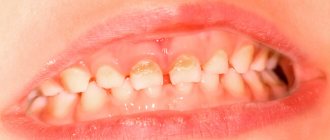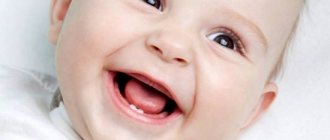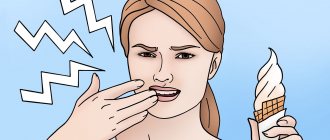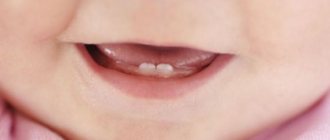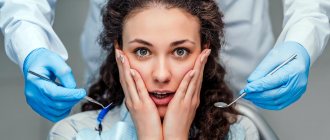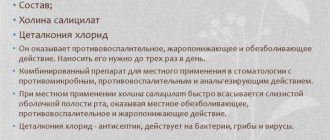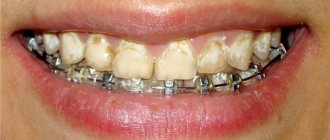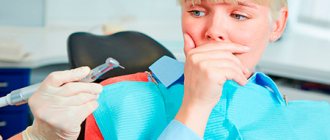Teething gel is a remedy for eliminating pain when it appears on the surface of the jaw and gums. This physiological process is uncomfortable not only for the child, but also for the parents. The baby becomes capricious and restless, refuses to eat, and often wakes up at night. Gels for gums during teething will help relieve pain and prevent tissue infection.
The drugs are safe for children and have passed all necessary laboratory tests. But they differ in efficiency, speed of impact, and cost. Often, mothers and fathers fail to choose a high-quality pain reliever for their baby the first time.
SIGNS OF TEETHING
The first teeth begin to erupt at a certain time - from 6 months to a year. But even healthy children can experience individual deviations. Pediatric dentists note that recently there has been a trend towards earlier teething. Such cases have not yet been observed in newborns. But the appearance of the first tooth in a 4-month-old child does not surprise anyone. This process is manifested by the following symptoms:
- swelling, redness of the gums;
- profuse salivation;
- cough due to saliva entering the respiratory tract;
- decreased sleep quality;
- nausea and sometimes vomiting as a result of swallowing saliva;
- slight bleeding from the gums (rare);
- deterioration of appetite up to refusal to eat;
- irritability and tearfulness.
When a child begins to teethe, he pulls all surrounding objects into his mouth. This often leads to irritation of the skin around the mouth and the formation of a rash. Often during feeding, the baby involuntarily clenches his jaw, biting hard on the nipple. In many children, body temperature rises to 38°C, causing weakness.
The teeth of an adult and a child differ in their anatomical features. Children have less hard tissue and a larger pulp volume. Therefore, their teeth react more sharply to the influence of external negative factors and are more often affected by caries.
Experts choose
The problem of choosing a drug for rapid healing and pain relief from damage to the oral mucosa is very relevant, both for adults and young patients, doctors and pharmacists. But why?
Many of these products require repeated use because they are quickly washed off with saliva, which is not very convenient to use. Meanwhile, in order to ensure regeneration, the drug must remain in the oral cavity for a long time without losing its effectiveness. What is the choice of specialists?
At first glance, it may seem that it is mainly children who suffer from stomatitis: learning the world by heart, they put foreign objects into their mouths, which, as a rule, are not very clean and can damage the oral mucosa. However, the microflora of the child’s oral cavity resists infection much more strongly. Therefore, stomatitis is a problem faced not only by children, but also by adults.
Common causes of stomatitis include lack of vitamins, decreased immunity, diseases of the digestive, cardiovascular and endocrine systems. Stomatitis can appear due to connective tissue diseases, viral infections, or be of an allergic nature. Local causes of stomatitis are often associated with some traumatic factor. For example, during the period of getting used to orthopedic prostheses, bedsores may appear. Or correcting a bite using a brace system often results in injury to the inner surface of the lips. Damage to the oral mucosa is possible after surgical interventions, implantation, professional hygienic cleanings, consumption of hot foods and drinks, etc.
Dentists also “cry”
Among professionals, stomatitis is considered one of the most difficult pathologies. First, saliva makes it difficult to maintain dryness. Secondly, it is impossible to isolate the oral cavity from various irritants by prohibiting the patient from eating. An effective regenerating agent must remain on the mucous membrane for a sufficient time, relieve pain and accelerate the healing process. Therefore, professionals prefer Solcoseryl® dental adhesive paste.
Solcoseryl® dental adhesive paste is designed specifically for rapid healing and pain relief of mucosal injuries. It took into account all the anatomical and physiological features of the oral mucosa. Solcoseryl® improves microcirculation, reduces swelling, shortens healing time and restores the mucous membrane. In addition, the dental adhesive paste contains the anesthetic polidocanol, which begins to act within 1-5 minutes after application and relieves pain within 3-5 hours. This is very important, given that any, even the most minor, damage to the oral mucosa is very painful.
Resilience is the key to recovery
Solcoseryl® dental adhesive paste is resistant to being washed off by saliva and forms a protective film that can remain on the surface of the wound for 2-5 hours. All this time, the paste protects the mucous membrane from irritants, and its active ingredients absorb discharge from the wound and promote a rapid healing process.
Does not contain antiseptics, hormones and sugar, which minimizes the risk of unwanted reactions and allows the paste to be used by patients with concomitant diseases.
At the reception and at home
Adhesive paste is used not only in the dentist's office - it can also be used at home. The paste is available in 5 g tubes - this is usually enough for the full course of treatment. A 0.5 cm strip of paste is applied to the previously dried area of the mucous membrane and slightly moistened with water.
What are the advantages of Solcoseryl® paste compared to other oral products?
SDAP is a universal dental paste that can be used in all cases associated with violations of the integrity of the oral mucosa. This is its main advantage. In addition, Solcoseryl® paste does not contain the antiseptic chlorhexidine, which makes it possible to use it for a long time, has a quick and long-lasting local analgesic effect, adsorbs discharge from the wound well, creates conditions for the fastest tissue regeneration, and has a cytoprotective and membrane-stabilizing effect.
What exactly is your recommendation for Solcoseryl® dental adhesive paste based on?
I recommend drugs based on data on their effectiveness, safety, and also take into account customer reviews. Dental adhesive paste Solcoseryl can be recommended for many indications - it is convenient. Solcoseryl®, unlike other oral products, adheres well to the mucous membrane and allows food intake, which patients really like. I keep some statistics on reviews, and everyone who used the adhesive paste was satisfied.
To which groups of patients and in what cases can Solcoseryl® dental adhesive paste be used?
To protect mucosal damage, relieve pain, and promote rapid healing, Solcoseryl® can be used by almost all age groups of patients. For diseases such as gingivitis, periodontitis, conditions after surgical interventions, installation of implants, removal of dental plaque, trauma to the mucous membrane during the period of adaptation to orthopedic and orthodontic structures. In addition, dental adhesive paste is also effective for damage to the mucous membrane caused by general diseases of the body. The paste can be used by children with stomatitis, as well as by pregnant women and nursing mothers - the drug is quite safe.
So, the choice of specialists is obvious - for professionals, Solcoseryl® dental adhesive paste is the means of choice in the treatment of inflammatory diseases and damage to the oral mucosa.
Source: Pharmacy Council Magazine
TYPES OF GELS
Teething gel for infants is usually multi-component. Each of the ingredients performs a specific function in improving physical and psychological well-being. But a certain active ingredient occupies a leading position in the composition of the drug. It is its medicinal properties that underlie the classification of gels for gums during teething:
- painkillers, mainly with lidocaine. Reduce the severity of pain and resolve swelling for several hours;
- homeopathic. Contain microscopic doses of dilutions of beneficial substances of natural origin. Reduces inflammation, relieves pain, accelerates the restoration of damaged tissues;
- anti-inflammatory. Stops inflammatory processes, eliminates pain and swelling of the gums. They have some antiseptic effect, inhibiting the spread of pathogenic microorganisms.
The pharmacy assortment also includes combination ointments for teething. Their components have a variety of therapeutic properties. Such drugs are usually used for severe teething symptoms.
RULES FOR APPLICATION OF GELS DURING TEETHING
Teething gel for babies will make life easier for the child and parents during this difficult period. When using it, you must follow all recommendations in the instructions for use. You should pay attention to the dosage regimen, age restrictions, and study the list of contraindications.
How to use dental products correctly:
- Apply a thin layer to the reddened area of the gums, gently rubbing in a circular motion;
- use the drug no more than five times a day and only if the baby is not feeling well;
- do not give the child food and water for about half an hour after using the gel to improve its adsorption;
- if ineffective, inform your doctor, who will prescribe an analogue with another active ingredient.
During treatment, it is imperative to follow all hygiene rules. You need to wash your hands before applying the gel with soap and water and dry them. You should only remove saliva and plaque from your child’s gums with sterile wipes.
Teething gel is a pharmacological drug that can cause side effects. Pediatricians recommend alternating and not combining it with pain-relieving drops or syrups. Sometimes a regular teether, pre-cooled, can cope with the pain.
Other medications for tooth pain
There are many other forms of painkillers that also help cope with the symptoms of acute toothache. The list of popular drugs is presented:
- Gels - used in childhood during teething; a similar effect is observed when the last molars appear in adults. Frequently used medications are represented by Cholisal, Solcoseryl, Dentol, Kamistad, Metrogyl Dent.
- Dental drops are safe preparations due to their natural components. In addition to the analgesic and sedative effect, the active ingredients affect inflammatory processes. Treatment is carried out by Denta, Dentaguttal, Dentinox, Dantinorm.
- Injections - to solve the problem, you can use conventional intramuscular medications (Ketonal, Ketorol, Diclofenac) or point-spectrum agents. Injection forms are used before tooth extraction or dental therapy; a strong analgesic effect is obtained when using Septodont, Ultracaine.
- Sprays or aerosols - local anesthesia is achieved by spraying a solution over the problem area. Inexpensive and affordable means include Lidocaine spray.
If you have acute or aching pain, you should not get carried away with any of the above medications. Regular use will reduce their effectiveness and will require an increase in dosage. After the first suppression of painful sensations, the patient should attend a consultation with a dentist. The doctor will help you find out the cause of the toothache and select appropriate therapeutic procedures.
BEST PAIN RELIEF GELS FOR TEETHING
There are increased requirements for children's medicines. They must be not only effective, but also absolutely safe. A high-quality gel for teething in infants eliminates pain 3-5 minutes after application. A good product helps strengthen enamel and protects damaged tissue from fungi and bacteria. Below is a list of drugs that meet all of the above requirements.
WITH COOLING EFFECT
Ointment for teething in children not only fights pain. With its help, you can also get rid of itching that makes you want to scratch your gums. It is even more dangerous than elevated temperature, as it can provoke an intestinal infection. For severe itching, it is advisable to use drugs with an analgesic effect.
The following cooling ointments have proven themselves especially well:
- Kamistad Baby. This is a combined inexpensive dental product that can be used on children of any age. Polidocanol irritates sensitive nerve endings located in the gum area. Due to the disruption of innervation, a pleasant feeling of coolness occurs, which distracts the child from pain. The second component is chamomile phytoextract with powerful anti-inflammatory and antiseptic properties. The gel has a pleasant mint-honey taste. Cost - 200 rubles;
- Dentinox. A product with a combined composition of lidocaine, chamomile phytoextract and lauromacrogol. This is an effective drug that facilitates teething in young children. It also reduces the risk of developing potential complications due to tissue infection. The principle of action of the product is to block nerve endings, eliminating gum soreness. Chamomile destroys bacteria and fungi, relieves inflammation and irritation of the gums. Price - 300 rubles.
Cooling gels have a long-lasting effect that lasts for 4 hours. After applying them, children feel relief after 3-5 minutes. They exhibit pronounced analgesic and antimicrobial activity and reduce local temperature.
When purchasing Kamistad, you should draw the pharmacist's attention to the fact that the drug is needed specifically for a child. It is called Kamistad Baby and is significantly different in composition from the product for adults. The latter is used only to treat children over 12 years of age.
WITH ANTI-INFLAMMATORY OR ANTISEPTIC EFFECT
The use of such ointments during teething in infants has a gradual effect on the body. First, the pain and itching subside, the glands stop producing excess saliva. Then swelling and inflammation are eliminated, the growth of pathogenic microflora is inhibited. And at the final stage, accelerated regeneration of mucous membranes and gum tissue begins.
The group of anti-inflammatory drugs includes the following gels:
- Kalgel. The use of this teething gel from 3 months is practiced for instant pain relief. The composition of the drug is represented by lidocaine and cetylpyridinium chloride. The last ingredient has pronounced antimicrobial and antiseptic properties. It inhibits the growth of opportunistic fungi that live in the oral cavity. Cetylpyridinium inhibits the proliferation of bacteria, mainly staphylococci and streptococci. And lidocaine quickly eliminates pain, as if “freezing” the area of the gum with the erupting tooth. Cost - from 330 rubles;
- Holisal. To form the active composition of the drug, the manufacturer used choline salicylate and cetalkonium chloride. Thanks to the complex effects of the components, all pathological processes in the baby’s oral cavity are inhibited. The drug exhibits analgesic and anti-inflammatory activity and reduces local temperature well. Tsetalkonium has an antifungal and antibacterial effect, promotes the resorption of edema. The gel should be used with caution in children under 1 year of age. Price - about 250 rubles;
- Baby Doctor First teeth. The drug in the form of a pinkish gel without taste or odor is used in the treatment of children from 3 months. The active composition is represented by calendula, echinacea, chamomile, plantain, and marshmallow root in the form of extracts. The product perfectly disinfects and has antiseptic and wound-healing properties. It stimulates the strengthening of local immunity, calms the central nervous system, and relieves inflammation. Cost - 315 rubles;
- Dentol. This group of dental products can also include Dentol with 7.5% benzocaine (200 rubles). The active component is a local anesthetic that can block the conduction of nerve impulses. A significant disadvantage of Dentol Baby is the short time of analgesic action. As a rule, after half an hour the anesthetic ceases to relieve pain.
Cholisal, Kalgel and other anti-inflammatory local analgesics should be used with caution. Do not exceed the dose, as if swallowed, the drugs can cause digestive disorders. When used correctly, it is possible not only to get rid of pain, but also to strengthen tooth enamel.
BEST HOMEOPATHIC REMEDIES FOR TEETHING
Homeopathic is a remedy with a small content of active ingredients. Presumably they cause symptoms in healthy people that are similar to the leading signs of a particular disease. The main principle of such therapy is “like cures like.” The baby’s body quickly gets used to the action of the components. Therefore, it stops reacting in any way to the teething process. The following drugs cope well with inflammation and pain:
- Dantinorm Baby. The composition of the drug for toothache is formed from chamomile, Indian ivy and rhubarb. All components are in a transparent solution in the form of concentrated extracts. A homeopathic remedy is intended for oral administration to eliminate pain and inflammation. Some parents additionally rub a drop of solution into the swollen gums. It is well tolerated, can improve digestion and calm the child. Sometimes the baby even falls asleep calmly a few minutes after taking the drug. Cost - 450 rubles;
- Pansoral. The drug from a French manufacturer contains phytoextracts of Roman chamomile, marshmallow root and saffron sativum. Plant ingredients gradually accumulate in the mucous membranes of the oral cavity. After creating a certain therapeutic concentration, they exhibit analgesic and anti-inflammatory effects. Saffron is a powerful natural antiseptic that quickly eliminates pathogenic microorganisms. The use of the gel allows you to normalize the functioning of the salivary glands and eliminate inflammatory swelling. You can buy Pansoral for 500 rubles.
Homeopathic remedies are usually well tolerated by children. But it is worth considering that their ingredients cannot be called hypoallergenic. Therefore, cases of local adverse reactions are sometimes observed. The allergy is manifested by a rash around the mouth, redness of the mucous membranes, and increased itching. This does not require stopping breastfeeding, but you should definitely consult a doctor.
Main groups of painkillers
To suppress toothache, the pharmaceutical industry offers a variety of medications, analgesics and NSAIDs.
Combination medications included in the NSAID subgroup are aimed at relieving inflammatory foci and pain. The active components determine what effect the tablet will have: relieve pain, reduce fever or suppress the inflammatory process.
The list of medications based on Ibuprofen is presented:
- Faspik, Deblok, Nurofen forte;
- MIG 400, Ibufen, Ibusan;
- Ibuklin, Nurofast, Next Uno express;
- Sedalgin sprint, Bonifen.
The drugs are designed to block unpleasant sensations, including acute toothaches. Tablets are used when the first molars appear in babies, or when the mucous membranes of the oral cavity are damaged or damaged.
Relief of discomfort occurs within an hour - this is a long time compared to medications with a similar spectrum of action. The drugs are prescribed to patients after dental procedures. The analgesic effect lasts for 8 hours, the medicine acts comprehensively.
Preparations made on the basis of Indomethacin are presented:
- Indocollir, Indobene, Metindol retard;
- Indotard, Methindol.
In dental practice, this series of medications is used to suppress serious inflammatory processes in the oral cavity, in the treatment of pain due to arthritis and arthrosis of the temporomandibular joint, after operations to relieve discomfort and reduce temperature. NSAIDs are applied externally, the expected effect of the gel occurs after 1-2 hours.
Pyrazolones are classified as analgesics, the main representative of the group is Analgin. Tablets for toothache begin to act half an hour after taking them, the effect lasts no more than 3 hours due to the rapid removal of active components from the body.
Treatment of the pathological condition is carried out using:
- Baralgetas, Bralangin, Geomag, Maksigan;
- Spasmoblock, Spasmalgon, Revalgin, Tempalgin;
- Plenalgina, Spazgan, Renalgan, Optalgina;
- Spasmalin, Bral, Spasmoton, Analgin-quinine.
Drugs in tablet form are freely available and do not require a doctor's prescription.
